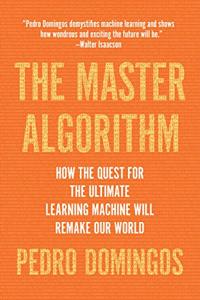
Want to learn the ideas in The Master Algorithm better than ever? Read the world’s #1 book summary of The Master Algorithm by Pedro Domingos here.
Read a brief 1-Page Summary or watch video summaries curated by our expert team. Note: this book guide is not affiliated with or endorsed by the publisher or author, and we always encourage you to purchase and read the full book.
Video Summaries of The Master Algorithm
We’ve scoured the Internet for the very best videos on The Master Algorithm, from high-quality videos summaries to interviews or commentary by Pedro Domingos.
1-Page Summary of The Master Algorithm
Overview
The most impressive thing about the human brain is how it can create a stream of consciousness, despite being only a pound of gray matter. It’s also amazing that little teaching is required for this to happen in the first few years of one’s life.
The human brain is the most sophisticated machine in existence. However, this may change as we create more advanced machines that can challenge our brains.
Machines have the ability to learn from large amounts of data. They can also ignore irrelevant information, which is helpful in making decisions. So let’s explore how machines make decisions and why they’re so useful.
In this passage, you will learn about the future of machine learning and how it could be used to improve your life. You will also find out why seeing patterns is not always a good thing, as well as how an algorithm for winning Tetris can help you get to work faster.
Big Idea #1: Machine learning can solve important problems by looking at data and then finding an algorithm to explain it.
Have you ever been frustrated with recipes because they’re imprecise? If so, then you might be someone who prefers an algorithm to a recipe. Unlike recipes, algorithms are precise and repeatable.
Algorithms are used in the background to schedule flights, route packages and make sure factories run smoothly.
Algorithms are designed to solve a specific task. If the task is to find directions, then an algorithm will take two points and return the shortest route between them. Machine learning algorithms go one step further: they produce other algorithms! They learn from examples of inputs and outputs and create rules that can be used for tasks that humans cannot describe with precision, such as reading handwriting. This comes in handy when trying to decipher something like writing, which we do unconsciously and would have trouble explaining how it works if asked.
Thanks to machine learning, we don’t have to analyze the components of handwritten text. We just give a computer many examples and get it to find common characteristics among them. Once it does that, we can use the algorithm for other tasks as well (like determining a parcel’s zip code) and solve problems automatically by using gathered data instead of human effort.
In math, many problems are solved by using the same underlying algorithms. Therefore, once you’ve learned a solution to one problem, it’s easier to apply that knowledge to solve other similar problems.
For example, you might think that making a medical diagnosis and filtering spam from your email are completely different things. However, with one algorithm and the right kind of data, you can solve both problems.
Big Idea #2: To avoid hallucinating patterns, learning algorithms need to be restricted and tested for validity.
Hallucinations are seeing things that aren’t really there. Interestingly enough, hallucinating is a problem in the world of algorithms. In 1998, The Bible Code claimed that the Bible contained hidden predictions by skipping lines and letters.
Critics argued that this assertion wasn’t true because similar patterns could be found in Moby Dick, as well as within Supreme Court rulings. This is an example of overfitting, which occurs when a model can learn anything thrown at it. The computer has too much power and will find any pattern to fit the data set until some arise. However, these models won’t work on other data sets.
To make sure algorithms are working properly, you need to limit their complexity and scope. With the right kind of limits in place, you can ensure that your algorithm is not too big or complex and that it will produce verifiable results.





